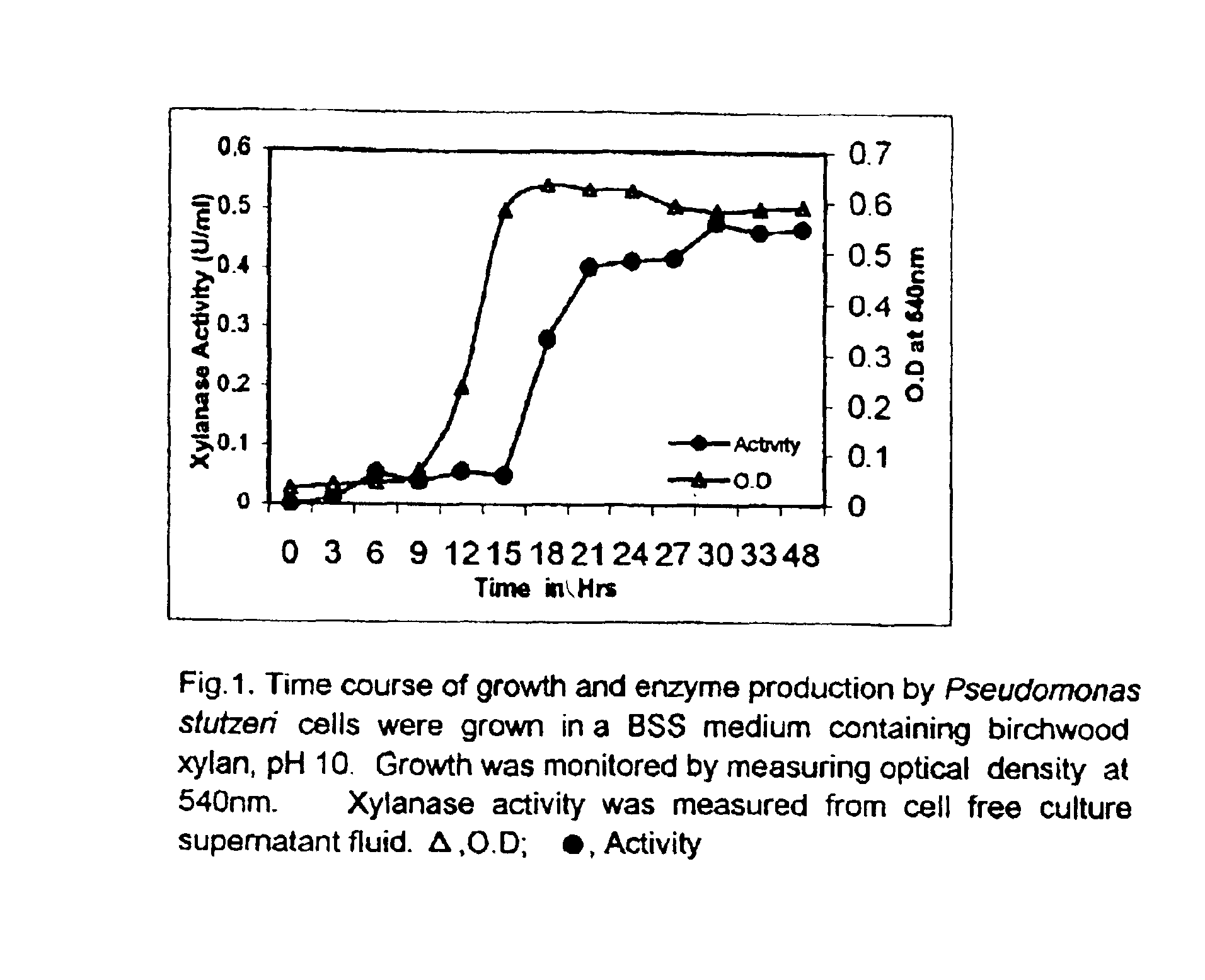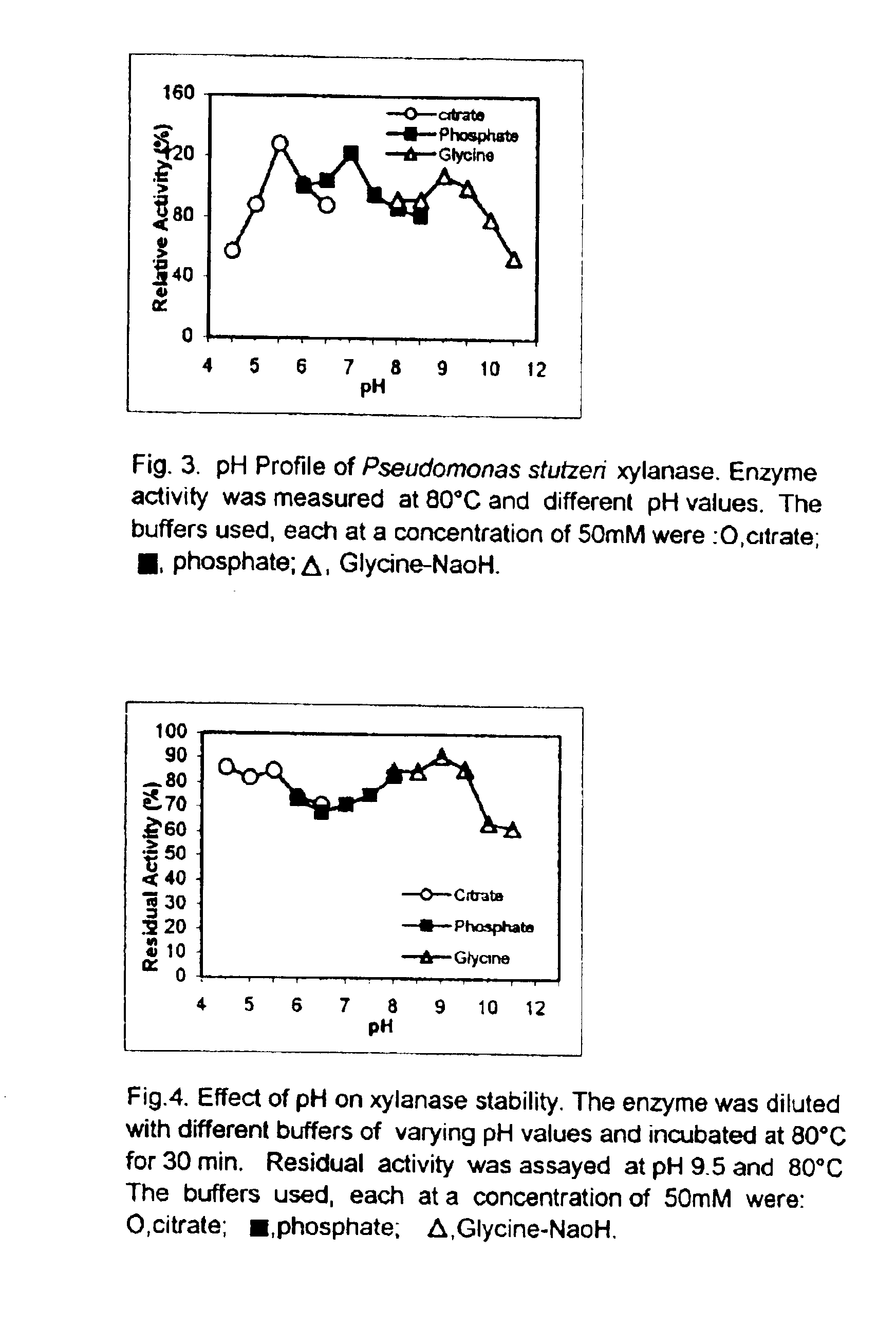'Pseudomonas stutzeri' strain and process for preparation of xylanase
a technology of xylanase and pseudomonas stutzeri, which is applied in the field of pseudomonas stutzeri strain and process for preparing xylanase, can solve problems such as environmental problems, and achieve the effect of enhancing the production of xylanase enzymes
- Summary
- Abstract
- Description
- Claims
- Application Information
AI Technical Summary
Benefits of technology
Problems solved by technology
Method used
Image
Examples
example 2
Precipitation and recovery of xylanase: Pseudomonas stutzeri was grown in the growth medium as defined above, supplemented with 0.1 grams of xylan as carbon source, for 48 hours. Cells were removed by centrifugation at 8000 RPM and 4.degree. C. Xylanase enzyme was isolated from the cell-free supernatant by adding 70 grams of ammonium sulphate per 100 milliliters of the cell-free supernatant. The precipitated enzyme was collected using a spatula and dissolved in 50 mM glycine-NaOH buffer, pH 9.5. The enzyme solution was dialysed overnight using the 50 mM glycine-NaOH buffer pH 9.5. The obtained dialysed solution of the enzyme was used to characterize the activity of the xylanase enzyme.
example 3
Effect of pH on xylanase activity and stability: The effect of pH on the activity of the xylanase enzyme was studied using 50 mM sodium citrate (pH 4 to 6), 50 mM phosphate (pH 6 to 8) and 50 mM glycine-NaOH (pH 7.5 to 11) buffers. In order to assess the stability of the enzyme at various pHs, one volume of the enzyme solution was mixed with one volume of the above buffer solution having different pHs (5 to 11) and incubated for 30 minutes. The enzyme showed three activity maxima at pH 5.5, 7, and 9.0 (FIG. 2). Stability studies showed that the enzyme was more stable at the alkaline pH of 8 (FIG. 3).
example 4
Effect of temperature on the xylanase activity and stability: The effect of temperature was studied by assessing the activity of the enzyme at various temperatures ranging from 30 to 100.degree. C. The enzyme activity increased with the increase in temperature (FIG. 4). The enzyme showed highest activity at 80.degree. C., and then showed some decrease, as the temperature was further increased to 100.degree. C. The activity of the enzyme at 80.degree. C. was higher by a factor of about 250 as compared to that observed at 30.degree. C. When the enzyme solution in a glycine-NaOH buffer of pH 9.5 was heated for 2 hours at 800 C (FIG. 5), 63% activity was retained. When the enzyme solution in glycine-NaOH buffer was heated for 80 minutes at 100.degree. C., 45% enzyme activity was retained (FIG. 6).
PUM
| Property | Measurement | Unit |
|---|---|---|
| temperatures | aaaaa | aaaaa |
| temperature | aaaaa | aaaaa |
| molecular weight | aaaaa | aaaaa |
Abstract
Description
Claims
Application Information
 Login to View More
Login to View More - R&D
- Intellectual Property
- Life Sciences
- Materials
- Tech Scout
- Unparalleled Data Quality
- Higher Quality Content
- 60% Fewer Hallucinations
Browse by: Latest US Patents, China's latest patents, Technical Efficacy Thesaurus, Application Domain, Technology Topic, Popular Technical Reports.
© 2025 PatSnap. All rights reserved.Legal|Privacy policy|Modern Slavery Act Transparency Statement|Sitemap|About US| Contact US: help@patsnap.com



